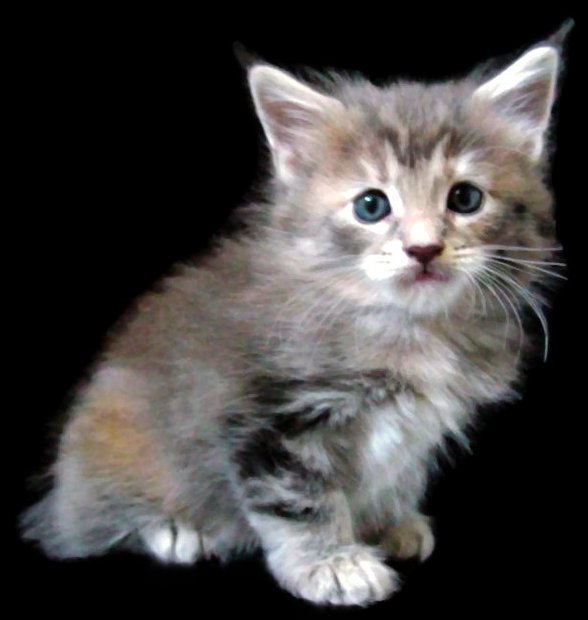|
|
|||
|
|
The Maine Coon
|
Cat &
Kitten Care
|
About
Us
|
Our
Cats
| |
|||
|
INTRODUCING A KITTEN TO A NEW HOUSEHOLD Like human babies, kittens require special care, including veterinary care, feeding and socialization. The best time to bring a kitten home is when you have at least one or two days to focus on helping him adjust to new surroundings. To transport your new kitten home safely, you’ll need a carrier. Leaving mom is a big deal for your kitten; a carrier will help her feel more secure. Don’t use another pet’s carrier because its smell could be stressful to your kitten. Place a towel in the carrier for warmth and to absorb urine in case of an accident, and be sure to carry an extra towel. Before you bring your kitten home, prepare a small room or space that will be her own for the first few days or weeks. Having a smaller area to explore at first will help your kitten get comfortable with her new home. Be sure to secure all electrical and blind cords because they can cause harm to your new kitten. Have all the supplies needed available and ready, such as water and food bowls, kitten food, a litterbox, a scratching post, safe toys and a bed. Cats don’t like to eat next to the litterbox, so place the litterbox on one side of the room and the food and water dishes on the other. Make sure that your kitten can get in and out of the litterbox without help; it might be necessary to provide a litterbox with low sides. To help your kitten feel secure, make sure that the room has hiding places. If there isn’t furniture to hide beneath, place cardboard boxes on their sides or cut doorways into them. Providing a warm and comfortable bed is essential. You can purchase a pet bed or line a box with something soft; using a sweatshirt that you’ve worn will help your kitten get used to your scent. When you bring your kitten home, put the carrier in the room you’ve prepared. Open the carrier door, but let your kitten come out when he is ready. After your kitten comes out, leave the carrier in the corner as another hiding place. Each day, scoop out the litterbox and provide fresh food and water. Your kitten may hide at first, but he will explore when no one is watching, becoming more comfortable with his new home. Your kitten will likely want plenty of attention from you. After your kitten becomes
comfortable in his room and develops a regular routine of eating, drinking and
using the litterbox, you can let him venture out into the rest of your house. At
this point, you need to make sure that your kitten stays safe and has enough
privacy to eat, sleep and use the litterbox. Keep your kitten’s bed, litterbox
and food/water dishes in the same place so that he knows where to find them.
Handling and playing with your kitten can help you bond with him. Your kitten
should be gradually introduced to other pets and children with care and
supervision. Introducing a kitten to a new household should be a gradual process. If you obtain a kitten that has been properly socialized by the breeder in the first place it will much easier to integrate into your household. You should prepare for the new kitten well ahead of bringing him home just like you would prepare for a new baby. It is important to continue using the same brand of food and type of litter the kitten has been use to in their previous household. Remember like young toddlers/puppies, your kitten may have the occasional accident which is to be expected and perfectly normal. When this happens, gently remind your kitten where the litter box is by placing him in it and/or placing another litter box in the spot where the kitten had the accident. Kitten Proofing Your Home prior to your kitten's arrival is essential. The care, continued socialization, training, discipline, love and attention you provide for your kitten will greatly influence the temperament of your kitten. Therefore it is important to ensure these needs are met and to love your kitten unconditionally like you would a child. A kitten that is alone most of the day may experience loneliness, boredom and frustration, possibly leading to troublesome behaviours. Therefore if your kitten must be left at home alone for most of the day, getting another kitten for companionship is recommended. Kittens are curious creatures capable of jumping onto high surfaces or squeezing into the smallest of spaces. To protect your kitten in his new environment, and to safeguard your belongings, kitten-proof your house. Kitchens/Bathrooms Use childproof latches to keep little paws from prying open cabinets Keep medications, cleaners, chemicals, and laundry supplies on high shelves. Keep trash cans covered or inside a latched cabinet Check for and block any small spaces, nooks, or holes inside cabinetry or behind washer/dryer units. Make sure your kitten hasn't jumped into the dryer before you turn it on. Keep foods out of reach (even if the food isn't harmful, the wrapper could be) Living/Family room Place dangling wires from lamps, VCRs, televisions, stereos, and phones out of reach. Keep kids' toys put away. Put away knick-knacks until your kitten has the coordination not to knock them over Check all those places where your vacuum cleaner doesn't fit but your kitten does, for dangerous items, like string Move houseplants -- which can be poisonous -- out of reach, including hanging plants that can be jumped onto from other nearby surfaces Be careful that you don't close your kitten in closets or dresser drawers Make sure all heating/air vents have a cover Put away all sewing and craft notions, especially thread Garage Move all chemicals to high shelves or behind secure doors Clean up all antifreeze from the floor and driveway, as one taste can be lethal to a kitten Bang on your car hood to ensure that your kitten (or any neighbourhood cats) has not hidden in the engine for warmth Bedrooms Keep laundry and shoes behind closed doors (drawstrings and buttons can cause major problems) Keep any medications, lotions, or cosmetics off accessible surfaces (like the bedside table) Move electrical and phone wires out of reach of chewing (Source: Little Shelter Animal Rescue & Adoption Center) Removing all Plants Poisonous to Cats is also a must.
Select a quiet room in your home and put his food, water, toys, scratching post, and litter pan in it. If you have one, a spare bedroom that can be closed off would be ideal. Kittens need to become thoroughly familiar with new surroundings before they feel comfortable. An entire house or apartment can be overwhelming all at once. It will be much less stressful for your kitten to learn about you, your family and your home a little at a time. This is even more important if there are multiple people and/or pets in your household. This will also help to establish good litter box habits from the very beginning. When introducing your kitten to other household pets, monitor them closely and do not leave them alone together until you are certain they will get along well. If you are introducing your kitten to a dog, make sure there are safe retreats in the house for him to get away if necessary. A baby gate across the doorway of one room works well. Introduce other family members slowly. Have them come into the room one at a time to pet and play with the kitten. Have younger children sit down, then show them how to gently stroke the kitten's fur and offer her a few treats. Make certain that children understand that they are not to chase the kitten, hurt her or bother her while she eats, sleeps or uses the litter box. If there are no other pets, you can let the kitten begin to explore the rest of the house in a few days. Please don't use your hands or feet as play objects with kittens. This type of rough play may cause biting and scratching behaviors to develop as your kitten matures. Instead provide plenty of toys that are intended to keep the kitten at an arms length away during play. Interactive toys like "kitty teasers" (not kitty teaser gloves, your cat may not be able to tell the difference between them and your hands!) are ideal as they allow kittens to practice their natural predatory instincts without causing harm to people. WATER Water is an essential nutrient and is needed by all living organisms for almost every bodily function. As cats are typically “small drinkers” quite often cat owners feel that their cat is not consuming enough water and tend to worry, especially when the cat is a regular consumer of dry foods. The cat can obtain its water from 3 sources: water from the food, drinking water, and the water produced when carbohydrates, proteins and fats are used. This "metabolic water" represents only 10-15 % of the total required water. When a cat is fed wet food, (cans or fresh meat or fish), it receives well over its water requirement from the water content of its diet. In these conditions, the cat will not drink or drink very little. On the contrary, when fed dry food, the cat has to obtain almost 100 % of its water requirement from drinking. A cat will drink water to compensate for water loss that may occur in three different ways. Water can be lost due to the action of salivation (licking) and respiration. This loss is minimal and at temperatures of approximately 85° F, panting will induce a water loss of less than 40 ml per day. Secondly, water can be lost during fecal output. The amount lost will vary depending on the nature of the food and on its digestibility: the more fiber there is in the food, the more important the water loss is. The main water loss, however, is urinary loss. When consuming a dry food, about half of the water consumed is eliminated in this manner. Cats do not tend to drink very much as they are able to considerably concentrate their urine as compared to other species (average density: 1045 compared to 1015 in dog and man). However, should the urine become too concentrated, the risk of crystal precipitation and urinary stone formation increases. It is essential that the cat be encouraged to drink. The recommended water consumption of the cat is 55 to 70-ml/kg-body weight/day or 1 ml/kcal of metabolizable energy consumed. These requirements increase if the water loss goes up, and for physiological or pathological reasons such as high fever, lactation, diarrhea, and vomiting. Cats are "finicky drinkers". They are very sensitive to the cleanliness of and to the taste of the water. To encourage a cat to drink, it is advised to let him have free access to water, to serve it in a clean bowl in glass, earthenware or stainless steel (avoid plastic materials as they may take up external odors), and to change the water twice a day. The ideal temperature of the water should be between 40 and 65° F to help encourage the cat to drink to prevent an increase in the concentration of the urine resulting in an increased frequency to disease. (Reprinted: Water Consumption In A Healthy Cat, by Gail Kuhlman, Ph.D., P.A.S. Diplomate, American College of Animal Nutrition) FOOD Kittens need roughly twice the nutrients of adult cats, for both growth and energy. Obviously, their tummies cannot handle large quantities of food, so much like human babies they need frequent feedings at first, tapering off as they grow. It is important during this time to weigh the kittens regularly, to ensure they are gaining regularly. Feeding Tips 1. Maintain your kittens current diet. When you first bring home your new pet, feed him the same food he was eating at his previous home. If you plan to change the food, do so gradually, mixing it with the kittens current diet. A sudden change can cause upset stomach and diarrhea. 2. Feed a high-quality, complete kitten diet. Such foods are specially formulated to meet the kittens unique nutritional needs, containing the proper balance of protein, vitamins and minerals. 3. Feed your kitten at the same time and same place each day. Kittens Kittens can be fed free choice as they will normally only eat as much as their body requires, provided they do not overeat as that may lead to digestive upset and/or excessive weight gain. Adults Unless accustomed to being overfed, most cats only eat the amount of food they need, so you can leave a bowl of dry food and water out for your cat to eat at will. However, if it is overweight, it's better to put your cat on a twice-a-day feeding schedule and regulate the amount of food given at each meal. Feeding directions provided on the food packaging should be followed. Cats will require more water when eating dry cat food, but tartar-build up may be lessened as a result of crunching on the kibble. Generally less expensive and less smelly. Dishes will remain clean and food will not build up nor spoil quickly. Stools will be firmer. Premium cat food, although more expensive than average brands, these foods are often better for your cat. They are low-bulk, which means that cats will digest more of the food, thus eating and eliminating less. They contain little or no dyes, which can be important if your cat vomits regularly (easier to clean up); probably also good from a diet viewpoint. These foods are also beneficial for the cats coats. TEETH Kittens are born without exposed teeth (edentulous). Like most mammals, including people, they are dyphyodont, erupting primary (decidious) teeth which are temporary and secondary (permanent) teeth. They have 26 temporary teeth and 30 permanent teeth. The permanent teeth should last for the life of the cat provided they are receiving good dental care. Kittens' primary (deciduous) teeth are all normally in by approximately 6-8 weeks of age. They come in as follows: Incisors ... 2-3 weeks Canines ... 3-4 weeks Premolars ... 3-8 weeks Kittens' secondary (permanent) teeth are all normally in by approximately 5-7 months of age. They come in as follows: Incisors ... 3-5 months Canines ... 4-5 months Premolars ... 4-6 months Molars ... 4-5 months
Taking Care Of Your Kitten's Teeth Kittens should be taught to have their mouths handled and teeth brushed at a young age. This ensures good oral health and saves you from trips to your veterinarian for costly dental cleanings. Kittens often experience pain and discomfort during the teething stages just like human infants and puppies do. During this time you may find them chewing on inappropriate objects in your home or on your fingers and clothing. To discourage this behaviour it is essential that you provide them with appropriate chew toys.
HOUSING FeLV and FIV can be transmitted at birth from the mother or through the bite of an infected cat. Neither virus can infect humans. Many outdoor and stray cats and kittens carry this infection. Because of the fatal nature of these diseases, you should not expose cats already living in your home by taking in untested cats or kittens. To be safe, keep your cat indoors. Cats can be happily kept inside all the time, and an indoor cat is much healthier and safer than an outdoor cat. But, if you have the space, you might want to consider providing your kitties with a "cat run" where they can go outside for fresh air at will and watch birds and doze in the sun. LITTER BOX We recommend a “jumbo” size litter pan, without a hood, like the ExquisiCat (jumbo size) Litter Pan or the Rubbermaid Pets High Sided Litter Pan which controls litter scatter for your Maine Coon cat. Rubbermaid Pets Cat Litter Caddy and Scoop and Rubbermaid Pets Litter Mat are also available. It may seem extremely large at first, particularly for a kitten, but in time you will be thankful you got the largest size pan available. We use and recommend only healthy, all natural, cat litters. Currently we are using Feline Pine Original Cat Litter. It is composed of 100% all-natural Southern Yellow Pine and is completely safe and healthy for your whole family and Mother Nature. When your cat uses Feline Pine, any ammonia odor is completely neutralized as it binds directly to the pine particles. Their unique drying process ensures that Feline Pine will absorb odors quickly. And the pleasant scent of pine will keep your home smelling fresh, naturally. It is completely biodegradable and can be used as compost. Sweat Scoop, and World's Best are other all natural alternatives you may want to consider based on your own personal preference. These items can be purchased at your local PetSmart or ordered online. An industrial grade spray bottle like Spraymaster filled with a dilute (1:20) bleach solution is useful for disinfecting litter boxes. The litter box should be placed in a quiet low traffic area of your home, away from your cat's eating and sleeping areas and be easily accessible by your cat.
|
|||
|
|
The Maine Coon
|
Cat &
Kitten Care
|
About
Us
|
Our
Cats
| |
|||
|
|



